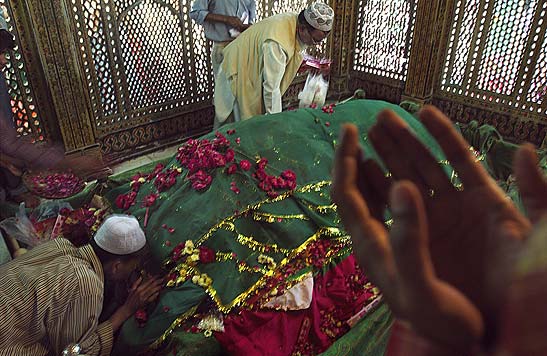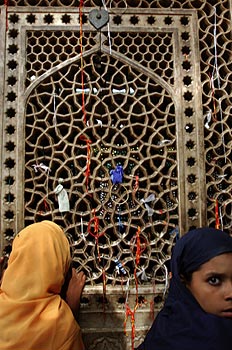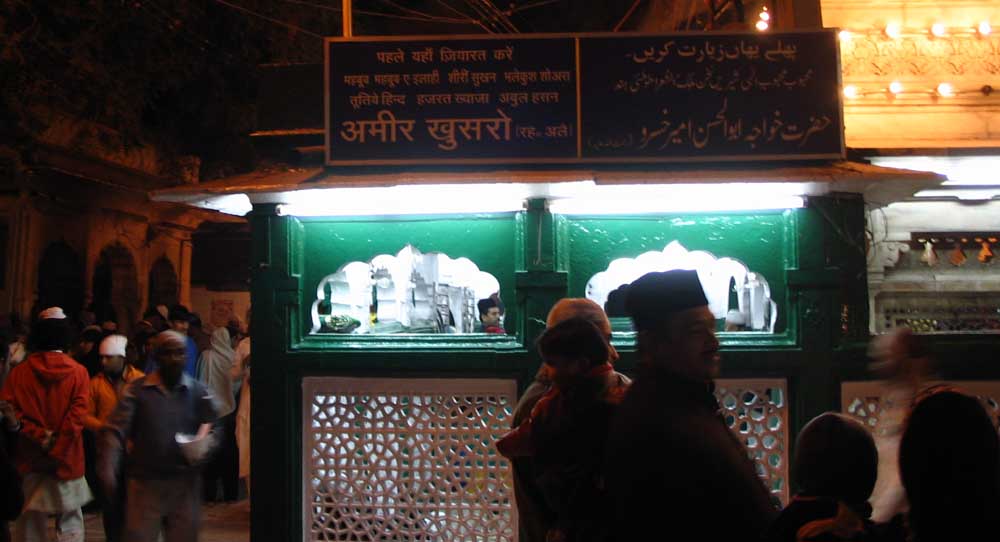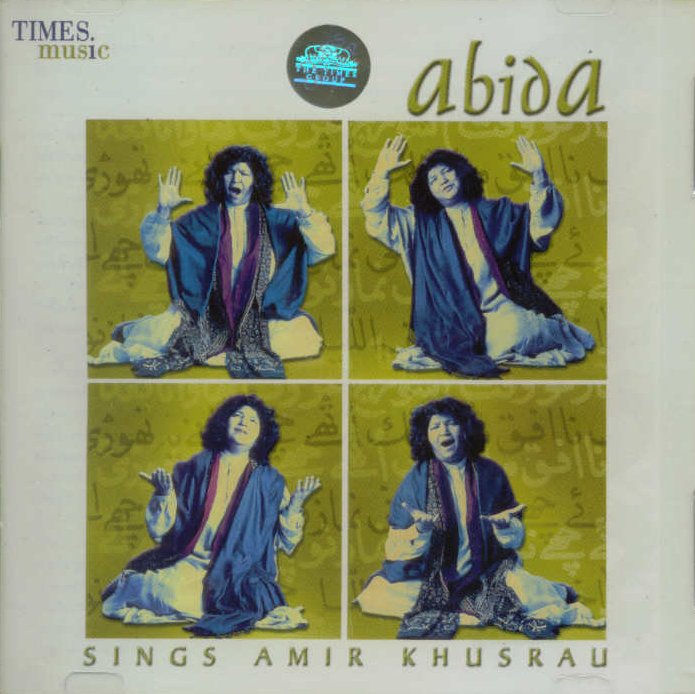

The tomb of Nizamuddin's devoted follower, the Indo-Persian poet Amir Khusrau (1253-1325), is also inside the shrine
Source: http://www.archnet.org/library/images/one-image.tcl?image_id=5615&collection_id=#?image_id=5615&collection_id=
(downloaded Nov. 2004)

Amir Khusrau's tomb attracts devotees in its own right
Source: http://www.time.com/time/asia/2004/journey/photoessays/india4.html,
image 4
(downloaded Nov. 2004)

Strips of cloth tied to the grill are tokens of pleas and vows made by visitors
Source: http://www.time.com/time/asia/2004/journey/photoessays/india4.html,
image 5
(downloaded Nov. 2004)

Amir Khusrau's tomb, lighted up, labeled in Hindu and Urdu, and attracting night visitors
Source: Courtesy of Rob McNamee, Columbia College, Jan. 2005

An illustrated manuscript of one of Amir Khusrau's poems (Iran, early 1500's)
Source: http://www.christies.com/LotFinder/search/LotDetail.asp?sid=&intObjectID=4483425&SE=CMWCAT03+627796+1887436625+&QR=M+1+60+Aqc0000900+610547++Aqc0000900+&entry=india&SU=1&RQ=True&AN=61
(downloaded Apr. 2005)
"NASR AL-DIN ABU'L HASAN, KNOWN AS AMIR KHOSRAW DEHLAVI (AH 651-725/1253-1325 AD): KHAMSA. SAVAFID IRAN, EARLY 16TH CENTURY. Persian manuscript on cream paper, 148ff. each with 17ll. of black nasta'liq in four columns in blue, margins brown and gold within black rules, catchwords, opening double-page illumination with two columns of text within panels of gold, orange and white floral arabesque on blue ground with gold cusped panels, three more similar headpieces, seven miniatures in gouache, gold and silver, text unfinished and without titles, black morocco binding with gold stamped panels and decoupe doublures, rebound so flap opens on the righthand side, generally in very good condition. 10 7/8 x 7in. (27.5 x 18cm.).
Lot Notes: A little-known version of the Khamsa by Amir Khosraw Dehlavi, the greatest Persian-langauage poet of medieval India. The fine miniatures are in extremely good condition.
Son of a Turkish officer and Indian mother, Amir Khosraw Dehlavi displayed precocious talent, working successively in the courts of the family of Sultan Baban in Bengal and Multan, and after the capture of the latter by the Mongols in AH 683/1284 AD, for the governor of Oudh Hatem Khan, before returning to Dehli to write for Sultan Jalal al-Din Khajli (AH 689-95/1290-6 AD), his assassin 'Ala al-Din Khajli (AH 695-715/1296-1315 AD), Qotb al-Din Mobarakashah (AH 716-20/1316-20 AD), Ghiayth al-Din Tuqluq (AH 720-25/1320-25 AD), and then briefly for Muhammad Tuqluq.
He strove to emulate all styles of poetry- from Arabic qasidas to ghazals and tarji's. Between AH 698-701/1398-1301 AD he wrote his version of the Khamsa after Nizami. It comprises matla' al-anwar, Majnun wa Layla, Shirin wa Khosraw, A'ina-ye Sekandari and Hasht Behesht(Encyclopaedia Iranica, Yarshater, E.(Ed.), New York 2001, pp.963-965.
The miniatures in this manuscript are as follows:
1. Khosraw falling in love seeing the portrait of Shirin (No portrait
is shown in the miniature)
2. Khosraw fighting the Romans
3. The slave girl Mushtari at the court of Khosraw
4. Farhad being alone in the wilderness
5. Khoraw and Shirin in their bed chamber at their wedding night.
6. Majnun's father going in search of his son in the wilderness.
7. The battle between tribal followers of Nawfal and Layla.

Some of his verses are extremely popular among modern qavvali singers like the famous Abida Parveen
Source: http://www.indianmusicstore.net/ghazal.htm
(downloaded Feb. 2006)
== Indian Routes index == Indian Routes sitemap == Glossary == FWP's main page ==